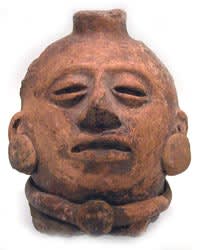Mayan Sculptural Fragment of a Head, 100 CE - 500 CE
Terracotta
3.25
PF.5727
Further images
The ancient Mayan civilization was perhaps the most advanced civilizations in the western hemisphere before the arrival of Europeans. Spanning the region that is now eastern and southern Mexico, Guatemala,...
The ancient Mayan civilization was perhaps the most advanced civilizations in the western hemisphere before the arrival of Europeans. Spanning the region that is now eastern and southern Mexico, Guatemala, Belize, El Salvador, and western Honduras, Mayan culture reached its pinnacle from about 300 to 900 A.D. They were sophisticated builders, constructing massive pyramid and temple complexes all without the technological advancements of the wheel or the arch. They were accomplished mathematicians; the first civilization to formulate the notion of the absence of value or zero, an extremely advanced mathematical concept. One of their greatest intellectual achievements was a pair of interlocking calendars, which was used for such purposes as the scheduling of ceremonies. Today, they are most famous for what they left behind: ruins of fabulous temples and cities, and extraordinary artifacts of sculpture and pottery.
This small sculptural fragment portrays a human head. The facial features have been finely molded. The eyes and mouth have both been indented so that the excess folds of the clay become the eyelids and lips. The protruding nose merges perfectly with the brow and forehead. The figure’s ears have been pierced and ornamented with two large discs. A necklace is worn with a large pendant shaped like the discs in the center under the slight indication of a chin. The top and back of the head reveal carefully crafted holes. What seems to be a mouthpiece for blowing, as in a whistle or flute, rises out of the top of the figure’s head. A round hole has been pierced into the flat, unadorned back, just under the “mouthpiece.” This tantalizing fragment is just a taste of the majesty that must have been the whole of the work in its entirety. Today, this sculpture comes down to us as mysterious as it is majestic.
This small sculptural fragment portrays a human head. The facial features have been finely molded. The eyes and mouth have both been indented so that the excess folds of the clay become the eyelids and lips. The protruding nose merges perfectly with the brow and forehead. The figure’s ears have been pierced and ornamented with two large discs. A necklace is worn with a large pendant shaped like the discs in the center under the slight indication of a chin. The top and back of the head reveal carefully crafted holes. What seems to be a mouthpiece for blowing, as in a whistle or flute, rises out of the top of the figure’s head. A round hole has been pierced into the flat, unadorned back, just under the “mouthpiece.” This tantalizing fragment is just a taste of the majesty that must have been the whole of the work in its entirety. Today, this sculpture comes down to us as mysterious as it is majestic.





